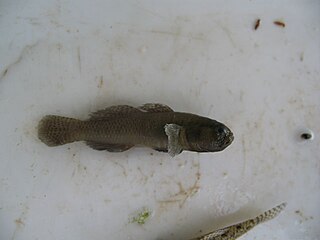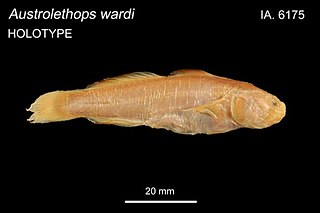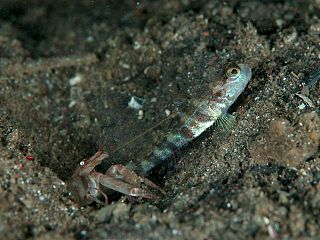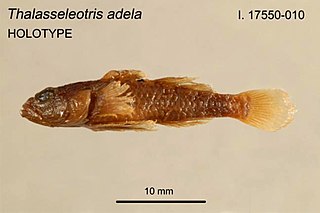Related Research Articles

Eviota hoesei, Doug's eviota, is a species of goby associated with reefs and tide pools. It has a limited distribution in the southwest Pacific, being found around New Caledonia, Lord Howe Island, Norfolk Island and the Elizabeth and Middleton Reefs at depths of from 0 to 25 metres. Within this limited area this is an abundant species.
Eviota readerae is a species of goby associated with reefs and tide pools. It has a very limited distribution in the southwest Pacific, being found only on the Elizabeth and Middleton Reefs and the Lord Howe Rise in the Tasman Sea.

Economidichthys is a genus of freshwater gobies endemic to Greece. The name of this genus honours the Greek ichthyologist Panos Economidis.
Glossogobius hoesei, Hoese's goby, is a species of goby endemic to the Ayamaru Lakes in West Papua, Indonesia where it can be found on muddy or gravel substrates as well as in small tributary streams. This species can reach a length of 7 centimetres (2.8 in) SL. The specific name honours the ichthyologist Douglass Fielding Hoese of the Australian Museum in Sydney who has made an important contribution to the study of fishes in the order Gobiiformes.
Silhouettea is a genus of gobies native to the Indian Ocean and the western Pacific Ocean. The name of this genus refers to the island of Silhouette in the Seychelles where the type specimens of the type species, Silhouettea insinuans, were collected.
Schindleria praematura, Schindler's fish is a species of neotenic goby which was formerly placed in the monogeneric family Schindleriidae but which is currently classified within the Gobiidae. It is associated with reefs and has an Indo-Pacific distribution from South Africa and Madagascar to Hawaii and the sea mounts of the South Pacific. The generic name and the common name honour the German zoologist Otto Schindler (1906–1959) who described the species.

Didogobius is a genus of small marine fish in the family Gobiidae, the true gobies. They are native to the eastern Atlantic Ocean and the Mediterranean Sea. The name of the genus is a compound noun made up of Dido, the mythical founder and first queen of Carthage, and the Latin gobius meaning "goby".
Gerald Robert "Gerry" Allen is an American-born Australian ichthyologist. His career began in 1963, when he spent a semester at the University of Hawaii, where he also received a PhD in marine zoology in 1971. In 1972, Allen wrote his doctoral thesis on the systematics and biology of the anemone fish.

The small-eyed goby is a species of goby native to tropical reefs of the Indian Ocean through the western Pacific Ocean where it inhabits areas of coral rubble. As its common name suggests, this species has particularly small eyes. This species grows to a length of 6 centimetres (2.4 in) TL. This species is the only known member of its genus. The small-eyed goby is specialised to feed on seagrass and they share a burrows with mud lobsters of the genus Thalassina. The specific name honours Charles Melbourne Ward (1903-1966), the Australian actor, naturalist and collector of specimens who collected the type specimen.
Barbuligobius boehlkei, the Cryptic bearded goby, is a species of goby native to the Indian Ocean and the western Pacific Ocean where it can be found on sand-rubble substrates at depths of from 1 to 15 metres. This species grows to a length of 2 centimetres (0.79 in) SL. This species is the only known member of its genus. Its specific name honours James E. Böhlke (1930-1982) of the Academy of Natural Sciences of Philadelphia.

Kelloggella is a genus of fish in the family Gobiidae, the gobies. This genus is distributed in the Indian and Pacific Oceans. The genus name honours the American entomologist Vernon Lyman Kellogg (1867-1937) of Stanford University, the discoverer of Kelloggella cardinalis.
Larsonella pumila is a species of goby native to the Indian Ocean from the coast of Africa to the western Pacific Ocean. This species grows to a length of 1.9 centimetres (0.75 in) SL. This species is the only known member of its genus. The specific name honours the ichthyologist Helen K. Larson who was the Curator of Fishes at the Museum and Art Gallery of the Northern Territory in Darwin, for her work on the taxonomy of Indo-Pacific gobies.

Myersina is a genus of ray-finned fish from the family Gobiidae, the true gobies which are found from the Atlantic coast of South Africa through the Indian Ocean to the western Pacific Ocean. The generic name honours the American ichthyologist George S. Myers (1905-1985) who was a younger colleague of Herre's at the time at which he described the genus and who went on to be president of the American Society of Ichthyologists and Herpetologists, the head of the Division of Fishes at the United States National Museum and an ichthyologist for the United States Fish and Wildlife Service.

Vanderhorstia mertensi, Mertens' shrimp goby or the slender shrimp goby, is a ray-finned fish species native to the Red Sea, Japan, Papua-New Guinea and the Great Barrier Reef. Male individuals can reach a length of 11 cm in total. In 2008 a first specimen was collected in the Mediterranean Sea, in the Gulf of Fethiye, southern Turkey, where it was found on sandy bottoms in the vicinity of beds of sea grass. It is now common in Israel, Turkey and Greece. According to the Mediterranean Science Commission this species most likely entered the Mediterranean via the Suez Canal from the Red Sea.
The specific name honours the German herpetologist Robert Mertens (1894-1975), the former director of the Naturmuseum Senckenberg in Frankfurt, from whom the author, Klausewitz, learnt about the biological and ecological view of modern systematics and taxonomy.

Thalasseleotris is a genus of gobies comprising two species in the family Thalasseleotrididae from the south-western Pacific Ocean in the seas off Australia and New Zealand. The generic name is derived from the Greek Thalassa meaning "sea" and the generic name Eleotris as at the time it was named the genus was considered to be in the family Eleotridae.
Pseudogobiopsis lumbantobing is a species of goby from the subfamily Gobionellinae which is found in Java and Sumatra where it occurs in freshwater rivers and streams at altitudes of 5–22 metres (16–72 ft), with substrates made up of sand, gravel, rock and boulders and where there may be growths of algae and aquatic macrophytes. This species had been traded in the European aquarium trade since 2001.
Ophiogobius jenynsi is a species of ray-finned fish from the biology Gobiidae, the true gobies. It is a demersal, marine species which is found off the coast of Chile in the intertidal zone. It feeds mainly on crustaceans. This species was originally named as Gobius ophicephalus by Leonard Jenyns in 1842, subsequently misspelt as ophiocephalus, but this name was preoccupied by Pallas's 1811 Gobius ophiocephalus, Hoese renamed the species in honour of Jenyns in 1976. This is the only species in its genus.
Ernest Albert Lachner was an American ichthyologist with an international reputation for his research on Indo-Pacific gobies and cardinalfishes.
Platygobiopsis hadiatyae is a species of goby, commonly known as a Renny's flat goby.
Stiphodon larson is a species of goby found in Papua New Guinea. This species can reach a length of 3.1 centimetres (1.2 in) SL.
References
- 1 2 3 4 Bernard Ebner (8 July 2014). "Anatomy of a fish taxonomist: Helen Larson". the morayslair. Retrieved 18 May 2019.
- 1 2 3 4 "Helen Larson". Australian Society For Fish Biology. Retrieved 18 May 2019.
- ↑ Christopher Scharpf; Kenneth J. Lazara (14 July 2018). "Order GOBIIFORMES: Family GOBIIDAE (I-p)". The ETYFish Project Fish Name Etymology Database. Christopher Scharpf and Kenneth J. Lazara. Retrieved 18 May 2019.
- ↑ Froese, Rainer; Pauly, Daniel (eds.) (2019). "Idiotropiscis larsonae" in FishBase . April 2019 version.
- ↑ Christopher Scharpf; Kenneth J. Lazara (29 January 2019). "Order BLENNIIFORMES: Families TRIPTERYGIIDAE and DACTYLOSCOPIDAE". The ETYFish Project Fish Name Etymology Database. Christopher Scharpf and Kenneth J. Lazara. Retrieved 18 May 2019.
- ↑ Christopher Scharpf & Kenneth J. Lazara (22 September 2018). "Order GOBIIFORMES: Family OXUDERCIDAE (p-z)". The ETYFish Project Fish Name Etymology Database. Christopher Scharpf and Kenneth J. Lazara. Retrieved 4 March 2022.
- ↑ Winterbottom, R. and D.F. Hoese, 1998. A new genus and four new species of fishes from the Indo-West Pacific (Pisces; Perciformes; Gobiidae), with comments on relationships. R. Ont. Mus. Life Sci. Occas. Pap. (37):1-17.